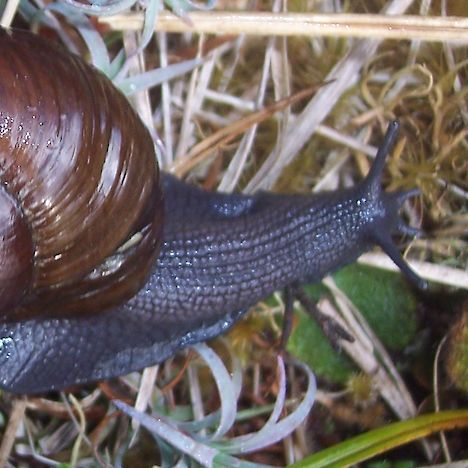Threat category:
Threatened: Nationally Endangered, At Risk: Declining, Chronically Threatened: Serious Decline?Regions:
Northland, Auckland, Wellington, Nelson-Tasman, WestcoastDistribution:
Northland, Auckland, southern North Island and South Island, especially Nelson and North Westland
Description
- New Zealand has a rich indigenous landsnail fauna. The largest of these are the kauri snail (Paryphanta) and Powelliphanta snails. The shell of the kauri snail is 60–79 mm wide and 33–44 mm high and coloured deep green, usually with some radial streaks of blackish-green. The shells of some Powelliphanta snails can exceed 100 mm in diameter, and range in colour from almost black, to ‘old gold’, to red-brown. New Zealand’s Amborhytida snails are smaller.
Interesting Facts
- The landsnail fauna of New Zealand is extremely diverse, with a high level of endemism.
- Most are restricted to certain habitats and abundant leaf litter is normally a prerequisite.
- Powelliphanta and Paryphanta snails are very susceptible to dehydration, are inactive during dry conditions, and tend to live in moist habitats such as rainforests and damp, mountinous habitat.
- Most are nocturnal and prey on earthworms and other invertebrates.
- They are hermaphroditic, with Powelliphanta snails laying up to 10 eggs per year.
- Though little is known about their life cycle, Powelliphanta and Paryphanta snails are thought to live for more than 20 years.
Association with Plantations
- All landsnails occasionally enter or can permanently live in plantation forests, e.g. Kauri snails (Paryphanta busbyi busbyi) live in exotic and indigenous forests in Northland and Auckland.
- Forestry operations have implications for several taxa including:
- Paryphanta busbyi busbyi (At Risk: Declining) – Northland, Auckland.
- Powelliphanta annectens (Chronically Threatened: Serious Decline) – Karamea-Kohaihai.
- Powelliphanta lignaria rotella (Threatened: Nationally Endangered) – Mokihinui Forest, Westland.
- Powelliphanta lignaria johnstoni (Threatened: Nationally Endangered) – Mokihinui Forest.
- Powelliphanta traversi tararuaensis (Threatened: Nationally Endangered) – Near Shannon, Manawatu.
Threats
- Predation of snails by introduced predators, particularly pigs, rats and possums is a serious threat. The relative impact of these predators can vary between sites (e.g. high pig impacts in some parts of Northland) or over time (e.g. possums seem to have acquired the habitat of eating Powelliphanta relatively recently).
- Locally, other predators, e.g. hedgehogs, song thrushes and weka, can have negative impacts.
- Habitat loss has greatly depleted the range of all groups and has isolated many populations. Most habitat loss has occurred in the past, but ongoing habitat loss is also a problem in many areas, due to land development and changing land use.
- Habitat deterioration caused by grazing mammals, e.g. livestock, goats, deer, pigs.
- Habitat damage and snail deaths caused by forestry operations.
- Collection of shells of dead snails, thereby removing calcium needed by live snails for shell growth.
Management Options and Methods
- Select sites for plantation forestry away from existing indigenous habitat known to contain giant land snails.
- Habitat protection:
- Maintain corridors and enclaves of indigenous vegetation. These areas will provide permanent habitat for snails as well as refuge during harvesting for many individuals (especially Paryphanta) that may have entered a plantation.
- Consider permanent protection of these natural areas.
- Harvesting procedures:
- Minimise impacts on remnant indigenous vegetation.
- Avoid ground-hauling logs and digging deep channels in sensitive areas.
- Translocate snails to more secure local site(s).
- Seek specialist advice (DOC, relevant specialists).
- Post-harvest:
- Avoid grazing, burning or spraying to encourage recovery of vegetative cover and higher ground moisture levels.
- Avoid disturbance of known snail habitat during land preparation.
- Fill in any ditches created during harvest.
- Predator control:
- Control pigs to low levels over a wide area, taking appropriate precautions if kiwi or other species sensitive to dogs are present in the area (refer Kiwi).
- Control possums to low levels (<5% RTC ) throughout the year (refer New Zealand pigeon).
- Consider controlling rats year round (<5% tracking levels). Because sustained rat control is currently problematical, consider beginning control in a core part of a snail’s range and work outwards as time goes on.
- When selecting a core area to manage, also consider other biota that may benefit (e.g. New Zealand pigeon, lizards) from integrated pest control.
- Maintain contact with DOC, Councils, landcare groups and other groups to co-ordinate pest control.
- Grazing and browsing:
- Exclude livestock from snail habitats.
- Control possums, deer and goats that could affect snail habitat.
- Stop shell collections:
- Prevent collection of shells of dead snails.
Monitoring Options
- Undertake snail surveys in all indigenous vegetation to be included in plantation forestry (refer to Terrestrial Invertebrates).
- Simple monitoring could include determining the predator species of a sample of snail shells (i.e. dead snails) every two years, e.g. spend a set amount of time searching randomly for snails in the management area and describe and assign predator sign, e.g. pig (flattened), possum (crunched from one side) and rat (gnawed around the whorl leaving jagged edges).
Leave snail shells in place. - Consult with DOC staff for specialist advice, e.g. crushing shells of dead snails to avoid confusion in later years, but still make calcium available for live snails. Ensure that snails are dead and that juveniles are not sheltering in larger shells.
- More standard monitoring could include a series of large plots throughout the management area, in which a careful search is undertaken for live snails every two years. Leave all snails (dead and alive) in situ.
Further Information and Support
- Brook F. 2002. Uncommon and rare landsnails in the Northland region of New Zealand and an assessment of conservation management priorities. Department of Conservation, Whangarei.
- Department of Conservation 2003. Beautiful giants of the forest floor: Powelliphanta landsnails.
- Walker K. 2003. Recovery plans for Powelliphanta land snails 2003-2013. Department of Conservation, Wellington.
- Monitoring and pest control – Department of Conservation.


